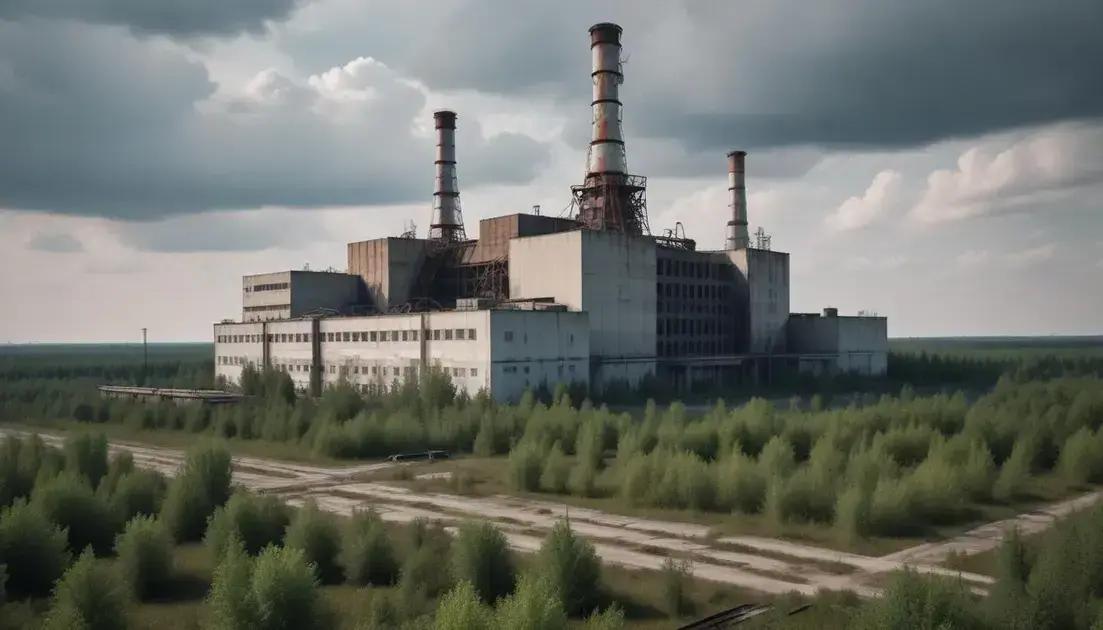
Chernobyl: Disaster, Silence and Radioactive Legacy
The Chernobyl disaster had far-reaching effects on nuclear safety regulations, health, and the environment. After the explosion in 1986, immediate impacts included health risks for thousands and loss of homes. Long-term consequences reshaped safety policies globally, leading to stricter controls and advanced monitoring technologies. The cultural legacy persists through art and historical reflection, while the exclusion zone has inadvertently become a wildlife sanctuary. Chernobyl serves as a critical lesson on the importance of safety in nuclear energy to prevent future catastrophes.
Chernobyl is a name that echoes with disaster and caution. Ever wondered how one nuclear incident could forever change safety protocols and communities? Let’s dive into its profound legacy.
Explosion of the reactor
The explosion of the reactor at Chernobyl was a catastrophic event. It happened on April 26, 1986, in the early morning. This accident released massive amounts of radiation into the atmosphere. People nearby were unaware of the danger.
The reactor was part of a nuclear power plant in Ukraine, which was then part of the Soviet Union. At that time, the plant was operating under a flawed safety design. A sudden power drop led to a series of mistakes. These errors caused a steam explosion, blowing off the reactor’s lid and releasing toxic materials.
Firefighters and workers rushed to the scene, trying to control the fire. They faced dangerous radiation levels without proper gear. Many of these brave individuals became seriously ill.
The explosion was so powerful that it sent radioactive debris into the air. It spread across Europe, affecting many countries. The nearby town of Pripyat had to be evacuated completely.
The Chernobyl disaster showed the world the risks of nuclear energy. It forced nations to rethink their safety measures and regulations. People learned the hard way how important it is to prioritize safety.
Immediate Effects of the Explosion
In the days following the explosion, the situation worsened. The uncontrolled reactor continued to release radiation. The Soviet Union eventually acknowledged the disaster after international pressure. Emergency workers were rushed in, but they faced high radiation levels.
Evacuations were chaotic. One moment, families were given little time to collect their belongings. The fear and confusion were overwhelming. Many residents had to leave their homes forever, leading to long-lasting effects on their lives.
Today, the area around Chernobyl remains uninhabitable. Nature has started to reclaim the land. Animals and plants thrive in the absence of human activity, but the legacy of the explosion still lingers.
This tragic event serves as a reminder. It highlights how vital safety measures are in managing nuclear power. Understanding the explosion’s impact can help prevent similar disasters in the future.
Immediate impacts on Ukraine
The immediate impacts on Ukraine after the Chernobyl disaster were severe. The explosion released a huge amount of radiation into the air. People in nearby towns, especially in Pripyat, were heavily affected.
Within hours of the blast, the Soviet government started evacuation plans. Residents had little time to pack their belongings. Many left everything behind as they rushed to safety. Can you imagine leaving your home and not knowing if you’d return?
The local environment suffered greatly too. Radiation spread quickly, contaminating the soil and water. This made many areas unsafe for farming and living. Crops were ruined, leading to food shortages.
Authorities declared a 30-kilometer exclusion zone around the plant. This zone is still in place today. People were forced to abandon their homes and lives, creating ghost towns.
Emergency responders rushed to the site, but they were not fully equipped. Many firefighters and plant workers faced extreme risks to contain the fire. Sadly, a number of them suffered from severe radiation sickness.
Hospitals in Ukraine quickly filled with people showing symptoms of radiation exposure. Medical teams worked tirelessly to help them. The health impacts were just starting to show.
This disaster changed public understanding of nuclear safety. It showed how serious and sudden the consequences could be. Many families were left with uncertainty about their loved ones who rushed into danger to help.
The emotional toll was heavy for the affected communities. People lost their homes, jobs, and even family members. It was a tragedy that changed lives forever.
Long-term consequences
The long-term consequences of the Chernobyl disaster are vast and troubling. The explosion caused severe environmental damage in the region. Many areas remain contaminated with radiation today.
One significant impact is on people’s health. Many individuals who lived nearby developed serious illnesses. These include cancers and other life-threatening diseases. Sadly, some children have shown signs of thyroid cancer.
The forced evacuation created ghost towns. Pripyat and nearby areas are still largely deserted. Nature reclaimed these places, but the scars of the disaster remain.
The disaster also changed policies worldwide. Countries began to rethink their approach to nuclear power. Many implemented stricter safety regulations to prevent similar incidents.
Economically, Ukraine faced challenges after the disaster. The cost of cleanup and health care was enormous. The government had to spend billions on recovery efforts.
People’s lives were forever altered. Many families were displaced and lived in fear. They had to adjust to a new normal without their homes and communities.
For generations, the shadow of Chernobyl loomed large. It shaped public opinion and created mistrust in nuclear energy. Many still remember the tragedy as a warning.
In response, scientific research increased. Scientists monitor radioactivity levels and study the effects on the environment. This research helps guide future safety measures and emergency responses.
The story of Chernobyl is not over. The land may heal, but the memories and effects will last. Understanding these long-term consequences is crucial for future safety and awareness.
Safety regulations reformed
The safety regulations reformed after the Chernobyl disaster changed how the world views nuclear power. The explosion raised serious concerns about safety standards. Many countries realized their systems needed improvement.
Before Chernobyl, safety practices were often lax. The incident revealed the dangers of poor safety measures. As a result, nations began reviewing their protocols.
In the years following the disaster, an international effort aimed to improve nuclear safety. Organizations like the International Atomic Energy Agency (IAEA) stepped up. They developed stricter guidelines and promoted better safety training for workers.
Countries learned to share information and resources. This cooperation helped raise safety standards globally. Many nations updated their nuclear reactors to be safer and more efficient.
New technology also played a role. Advanced monitoring systems can now detect issues before they become serious. This proactive approach helps prevent accidents.
Regulatory bodies focused on emergency preparedness. They created comprehensive plans that detail how to respond to nuclear incidents. Regular drills and training exercises keep workers ready for any situation.
Public confidence began to improve with these changes. People felt safer knowing that rigorous standards were in place. However, skepticism about nuclear energy still exists in some communities.
In summary, the reforms in safety regulations launched a significant shift. The world moved towards stricter oversight and better practices. Today’s regulations reflect the hard lessons learned from Chernobyl.
Cultural and environmental legacy
The cultural and environmental legacy of Chernobyl is profound and complex. The disaster not only impacted the people and the land but also shaped cultural narratives around nuclear energy.
After the explosion, the area became a cautionary tale. Movies, books, and documentaries explore the events and aftermath. These stories remind us of the risks of nuclear power.
Artistically, Chernobyl inspires various forms of expression. From photography to films, many creators highlight the haunting beauty of abandoned towns. The juxtaposition of nature reclaiming the land against man-made structures is striking.
Environmentally, the exclusion zone is unique. It became a wildlife sanctuary, as humans left. Animals roam freely, showing resilience in a contaminated environment. This unexpected twist fascinates scientists and ecologists.
Research in the Chernobyl area helps us understand radiation’s long-term effects. Scientists study how plants and animals adapt to radiation. Their findings inform safety measures and conservation efforts globally.
The disaster also shaped local identities. Survivors carry the memories and traumas of Chernobyl with them. Their stories are a part of their culture and history. Community gatherings often reflect on these experiences.
In recent years, tourism has grown in the Chernobyl area. People visit to learn about the disaster firsthand. They witness the remnants of a tragic past, creating a dialogue between history and memory.
The legacy of Chernobyl is a reminder to prioritize safety and respect the environment. It teaches us valuable lessons about the balance between technology and nature.
Conclusion
In conclusion, the Chernobyl disaster profoundly shaped our understanding of nuclear power and safety. The immediate impacts on people and the environment were devastating. However, the long-term effects continue to teach us valuable lessons.
The reformed safety regulations highlight how the world has learned and adapted. Chernobyl serves as a reminder of the importance of strong safety measures and emergency preparedness. The cultural and environmental legacy is complex, showing both the resilience of nature and the importance of remembering history.
By reflecting on Chernobyl, we can better understand the balance between technology and safety. It is crucial to prioritize safety in all areas of energy production, ensuring that history does not repeat itself. Ultimately, our commitment to learning from the past will help us create a safer future.


